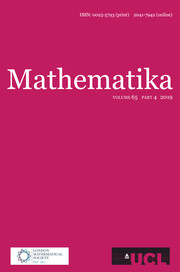Article contents
An algebraic approach to the growth of class numbers of binary quadratic lattices
Published online by Cambridge University Press: 26 February 2010
Extract
Two basic approaches have been used to develop explicit formulae for the number of classes in a genus of binary quadratic lattices over an algebraic number field. Analytic machinery in the form of the Minkowski-Siegel Mass Formula or the Tamagawa number of an algebraic group was employed by Pfeuffer [13] and Shyr [17] to obtain such a formula for maximal positive definite lattices over totally real number fields. On the other hand, Peters [10] observed that a formula applicable to maximal lattices over any number field can be deduced by algebraic methods from the theory of quadratic field extensions. Using group-theoretic techniques set up by the present authors [3] along with the calculation of certain local unit indices, Korner [6] derived the corresponding formula for non-maximal lattices.
Information
- Type
- Research Article
- Information
- Copyright
- Copyright © University College London 1981
References
- 5
- Cited by

